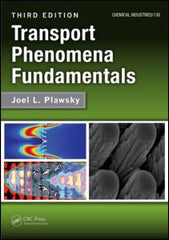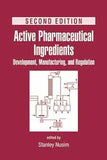Transport Phenomena Fundamentals, Third Edition By Joel L. Plawsky
Transport Phenomena Fundamentals, Third Edition
By Joel L. Plawsky
CRC Press – 2014 – 838 pages
Series: Chemical Industries
Hardback
2014 edition
The third edition of Transport Phenomena Fundamentals continues with its streamlined approach to the subject of transport phenomena, based on a unified treatment of heat, mass, and momentum transport using a balance equation approach. The new edition makes more use of modern tools for working problems, such as COMSOL®, Maple®, and MATLAB®. It introduces new problems at the end of each chapter and sorts them by topic for ease of use. It also presents new concepts to expand the utility of the text beyond chemical engineering.
The text is divided into two parts, which can be used for teaching a two-term course. Part I covers the balance equation in the context of diffusive transport—momentum, energy, mass, and charge. Each chapter adds a term to the balance equation, highlighting that term's effects on the physical behavior of the system and the underlying mathematical description. Chapters familiarize students with modeling and developing mathematical expressions based on the analysis of a control volume, the derivation of the governing differential equations, and the solution to those equations with appropriate boundary conditions.
Part II builds on the diffusive transport balance equation by introducing convective transport terms, focusing on partial, rather than ordinary, differential equations. The text describes paring down the microscopic equations to simplify the models and solve problems, and it introduces macroscopic versions of the balance equations for when the microscopic approach fails or is too cumbersome. The text discusses the momentum, Bournoulli, energy, and species continuity equations, including a brief description of how these equations are applied to heat exchangers, continuous contactors, and chemical reactors. The book also introduces the three fundamental transport coefficients: the friction factor, the heat transfer coefficient, and the mass transfer coefficient in the context of boundary layer theory. The final chapter covers the basics of radiative heat transfer, including concepts such as blackbodies, graybodies, radiation shields, and enclosures. The third edition incorporates many changes to the material and includes updated discussions and examples and more than 70 new homework problems.
Part I Transport Fundamentals and 1-D Systems
Introductory Concepts
Introduction
Scope of Transport Phenomena
Preliminary Assumptions
Equilibrium Foundations
Defining Equilibrium
Fluid Statics
Buoyancy and Stability
Fluids in Rigid Body Motion
Problems
References
Flows, Gradients, and Transport Properties
Introduction
Momentum Transport: Newton’s Law of Viscosity
Energy Transport: Fourier’s Law of Heat Conduction
Mass Transport: Fick’s Law of Diffusion
Charge Transport: Ohm’s Law of Conduction
Driving Force: Resistance Concepts
Flux Laws in Two and Three Dimensions
Mechanistic Differences between the Transport Phenomena
Primary and Secondary Fluxes
Failure of the Linear Flux: Gradient Laws
Summary
Problems
References
Transport Properties of Materials
Introduction
Viscosity of Gases
Viscosity of Liquids: Free Volume Theory
Thermal Conductivity of Gases
Thermal Conductivity of Liquids
Thermal Conductivity of Solids
Diffusivity of Gases
Diffusion in Liquids
Diffusion in Solids
Conductivity, Mobility, and Resistivity
Summary
Problems
References
1-D, Steady-State, Diffusive Transport
Introduction
Boundary Conditions
Boundary Condition Catalog
1-D, Steady-State Diffusive Transport
Composite Media
Variable Transport Properties, Coupled Transport, and Multiple Fluxes
Summary
Problems
References
Generation
Introduction
Generation on the Boundary: Boundary Conditions
One-Dimensional Transport with Generation at the Boundary
Constant Generation Terms
Variable Generation and Coupled Transport
Summary
Problems
Accumulation
Lumped Capacitance
Internal Gradients and Generalized Solutions
Semi-Infinite Systems
Moving Boundary Problems
Periodic Flow in a Rotating Cylindrical System
Summary
Problems
References
Conservative Transport and Waves
Introduction
Momentum Transport
Summary
Problems
References
Transport Enhancement Using Extended Surfaces
Introduction
Heat Transfer: Finned Surfaces
Mass Transfer: Gills, Lungs, etc
Diffusion and Reaction in a Catalyst Pellet
Summary
Problems
References
Part II Multidimensional, Convective, and Radiative Transport
Multidimensional Effects, Potential Functions, and Fields
Introduction
Laplace’s Equation and Fields
Solutions of Laplace’s Equation
Generation, Sources, Sinks, and Poisson’s Equation
Transient Systems
Summary
Problems
References
Convective Transport: Microscopic Balances
Introduction
Momentum Transport
Energy Transport
Mass Transport
Charge Transport
Summary
Problems
References
Macroscopic or Engineering Balances
Introduction
Macroscopic Continuity Equation
Macroscopic Momentum Balance
Macroscopic Mechanical Energy Balance: Extended Bernoulli’s
Equation
Macroscopic Energy Balance
Macroscopic Species Continuity Equation
Macroscopic Charged Species Continuity Equation
Summary
Problems
References
Convective Transport on a Flat Plate (Laminar Boundary Layers)
Introduction
Convective Transport Coefficients, Cf, h, kc, and k±
Boundary Layer Definitions
Derivation of Boundary Layer Equations
Transport Analogies
Hydrodynamic Boundary Layers
Thermal Boundary Layers
Mass Transfer Boundary Layers
Simplified Ionic Boundary Layers
Summary
Problems
References
Convective Transport: Systems with Curvature
Introduction
Flow over Cylinders
Flow over Spheres
Velocity Profiles in Tubes
Heat and Mass Transfer Applications
Coefficients
Taylor Dispersion
Summary
Problems
References
Turbulent Boundary Layers
Introduction
Turbulent Boundary Layer Structure
Transport Equations in Turbulent Flow
Representing the Reynolds Flux Components
Friction Factors and Other Transport Coefficients
Summary
Problems
References
Radiative Transport
Introduction
Preliminary Definitions
Maxwell’s Equations and Heat Transfer
Energy Fluxes in Radiative Systems
Blackbody
Graybody
View Factors
Radiative Energy Exchange
Summary
Problems
References
Nomenclature
Appendix A: Vector Mathematics
Appendix B: Mathematical Functions
Appendix C: First Eigenvalue for 1-D Transient Conduction with External Convection
Appendix D: Exact Solution to the Boundary Layer Equations
References
Appendix E: Blackbody Emission Functions
Appendix F: Thermodynamic and Transport Properties of Materials
Collision Integrals
References
Appendix G: Comsol® Modules
Index


















